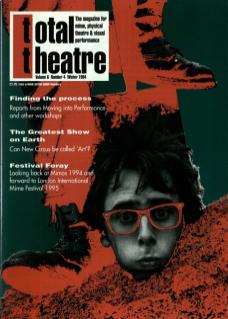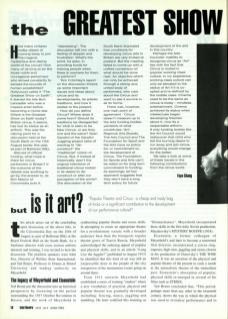How many children today dream of running away to join the magical, mysterious and daring world of the circus? How many of us long to be like those noble and courageous performers who strived constantly to exceed the bounds of human possibilities? Hollywood called it ‘The Greatest Show on Earth’. It starred the late Burt Lancaster who was a trapeze artist before becoming a movie star. Where is the Greatest Show on Earth today? British circus, it seems, has lost its status as an artform. This was the rallying point for a discussion held at the South Bank on the 10th August earlier this year, as part of Ballroom Blitz.
Starved of official funding, what hope is there for circus performers in Britain? If the outcome of the debate was anything to go by, the answer is, as Bim Mason of Circomedia puts it, ‘depressing’. The discussion left him with a feeling of despair and frustration. What's the point, he asks, in providing funds for training people when there is nowhere for them to perform?
Tom Critchley's report on the discussion throws up some important issues and ideas about circus and its developments, its artistic traditions, and how it relates to the present.
How do you define Circus? Where does it come from? Should its traditions be disregarded for what is seen to be New Circus, or are they one and the same? Sean Gandini of the Gandini Juggling project talks of wanting to ‘deconstruct’ the ‘traditional’ notion of Circus. But, if looked at historically, aren't the original intentions of traditional circus rooted in its desire to deconstruct or alter our perception of the world? The discussion at the South Bank illustrated that conditions for developing circus arts in Britain are very limited at present. But the meeting failed to come up with a unified consensus on what should be done next. An objective which can only be achieved through a strong and united body of performers, who care about the Circus and want to see it survive in all its forms.
There was, however, one main point of agreement – Circus doesn't measure up to the Arts funding bodies yardstick of what constitutes ‘Art’. Regional Arts Boards, the Arts Council and the Foundation for Sport and the Arts have no policy for, or commitment to, the development of Circus. The Foundation for Sports and Arts can't be relied on for long-term commitment to funding; its seemingly ad hoc approach suggests that they don't have a long-term policy for future development of the arts in this country.
Perhaps the Arts Council’s inability to recognise circus as ‘Art’ lies with the fact that Circus is rooted in popular working class culture. In my experience, working class culture can only be elevated to the status of Art if it is co-opted and redefined by the middle class. Cinema used to be the same as circus is today – mindless entertainment. Cinema achieved its status when intellectuals began developing theories about it, now its a respectable artform. If only funding bodies like the Arts Council would rediscover that child who felt the burning desire to run away and join the circus, everything would change for the better.
We take a look at some of these issues in the following contributions from the circus world.

